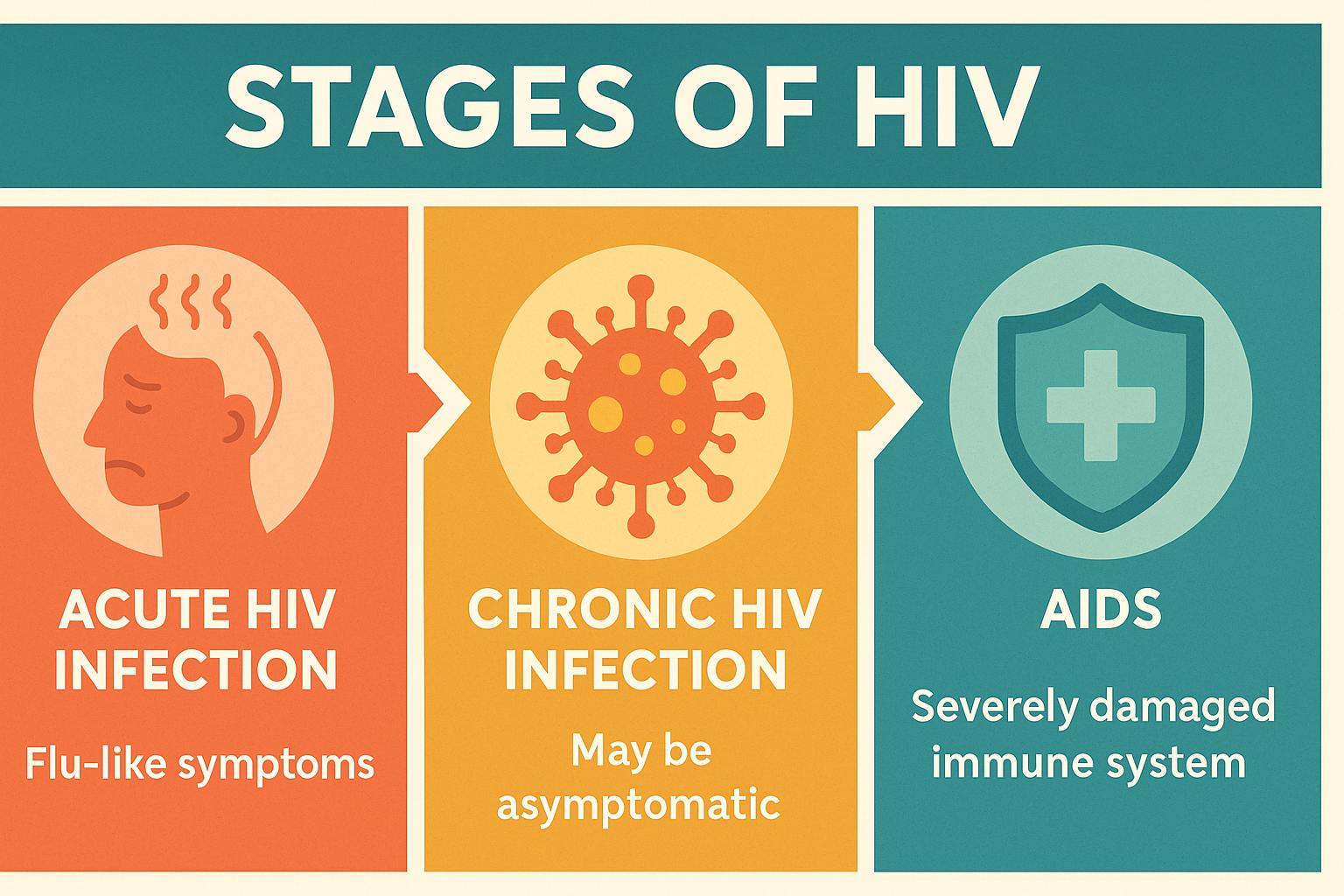HIV, or Human Immunodeficiency Virus, is a condition that affects millions of people worldwide. One of the most challenging aspects of HIV is that it can exist in the body without causing noticeable symptoms for years. This phenomenon, known as asymptomatic HIV, makes regular testing crucial for early detection and treatment. In this article, we’ll explore the concept of asymptomatic HIV, its implications, and why it’s so important to stay informed and proactive about your health.
Key Takeaways:
- HIV can be present in the body without causing noticeable symptoms for years
- Up to 80% of people with HIV experience flu-like symptoms 2-6 weeks after infection
- The asymptomatic phase can last up to 10 years without proper treatment
- Regular HIV testing is essential, even if you feel healthy
- Early diagnosis and treatment can prevent the progression to AIDS and reduce transmission risk
What is Asymptomatic HIV?
Asymptomatic HIV refers to the stage of the infection where an individual carries the virus but doesn’t show any obvious signs of illness. This phase can last for several years (up to 10), during which the virus continues to replicate and damage the immune system slowly.
The Stages of HIV Infection

To understand asymptomatic HIV better, it’s helpful to look at the three main stages of HIV infection:
- Acute HIV Infection (Stage 1)
- Chronic HIV Infection (Stage 2)
- AIDS (Acquired Immunodeficiency Syndrome) (Stage 3)
Asymptomatic HIV typically occurs during Stage 2, also known as chronic HIV infection or clinical latency.
Acute HIV Infection: The Initial Stage
The acute stage of HIV infection usually occurs within 2-4 weeks after exposure to the virus. During this time, about two-thirds of people experience flu-like symptoms, which are often mistaken for other illnesses.
Common HIV symptoms during the acute stage include:
- Fever
- Fatigue
- Muscle aches
- Sore throat
- Swollen lymph nodes
- Rash
These symptoms typically last for a week or two and then disappear. Not everyone experiences these initial symptoms, and some people may not have any symptoms at all during this stage.
Chronic HIV Infection: The Asymptomatic Phase
After the acute stage, HIV enters a period of clinical latency, also known as chronic HIV infection. This is when the virus becomes asymptomatic for many people.
Key points about the asymptomatic phase:
- It can last up to 10 years or more without treatment
- The virus continues to replicate at low levels
- The immune system gradually weakens over time
- People often feel healthy and may not realize they have HIV
Even though there are no obvious symptoms during this stage, the virus is still active in the body. That’s why it’s so important to get tested regularly, especially if you think you might have been exposed to HIV.
Why Asymptomatic HIV is Concerning
Asymptomatic HIV is a major concern for several reasons:
- Delayed Diagnosis: Without noticeable symptoms, many people don’t realize they have HIV and may not get tested.
- Continued Transmission: People with undiagnosed HIV can unknowingly transmit the virus to others.
- Missed Treatment Opportunities: Early treatment can significantly improve long-term health outcomes and quality of life.
- Silent Progression: Even without symptoms, the virus continues to damage the immune system.
The Importance of Regular HIV Testing
Because HIV can be asymptomatic for so long, regular HIV testing is crucial. The Centers for Disease Control and Prevention (CDC) recommends that everyone between the ages of 13 and 64 get tested for HIV at least once as part of routine healthcare
People at higher risk should get tested more frequently:
- Men who have sex with men (MSM) should get tested at least annually
- People who inject drugs should get tested at least annually
- Sexually active people with multiple partners should get tested annually
Treatment for Asymptomatic HIV
If you’re diagnosed with HIV during the asymptomatic phase, don’t worry. With early treatment, people with HIV can live long, healthy lives. The standard treatment for HIV is antiretroviral therapy (ART).
Benefits of early treatment include:
- Slowing the progression of HIV
- Preventing transmission to sexual partners
- Reducing the risk of developing AIDS
- Improving overall health and life expectancy
Living with Asymptomatic HIV
If you’ve been diagnosed with asymptomatic HIV, here are some tips for staying healthy:
- Start and stick to your treatment: Take your medications as prescribed by your doctor.
- Maintain regular check-ups: Visit your healthcare provider regularly to monitor your health and adjust treatment if needed.
- Practice safe sex: Use condoms and communicate with your partners about your status.
- Eat a healthy diet: A balanced diet can help support your immune system.
- Exercise regularly: Physical activity can boost your overall health and well-being.
- Manage stress: Chronic stress can weaken your immune system, so find healthy ways to relax.
- Avoid harmful substances: Limit alcohol consumption and avoid recreational drugs.
The Future of HIV Treatment and Prevention
Research into HIV treatment and prevention is ongoing. Some exciting developments include:
- Long-acting injectable treatments
- Potential HIV vaccines
- Improved testing methods
While these advancements are promising, the best approach remains early detection through regular testing and prompt treatment.
Summary
Remember, knowledge is power when it comes to HIV. By understanding asymptomatic HIV and the importance of regular testing, you can take control of your health and contribute to preventing the spread of HIV. If you have any concerns or questions about HIV, don’t hesitate to speak with a healthcare provider. They can provide personalized advice and support based on your individual situation.
FAQS
Can you have HIV and not know it?
Yes, it’s possible to have HIV and not know it. During the asymptomatic phase, which can last for years, people with HIV often feel healthy and show no obvious signs of infection.
How long can you have HIV without knowing?
Without testing, a person can have HIV for many years without knowing. The asymptomatic phase can last up to 10 years or more without treatment.
What are the early signs of HIV?
Early signs of HIV, which occur 2-4 weeks after infection, can include flu-like symptoms such as fever, fatigue, muscle aches, sore throat, and swollen lymph nodes. However, not everyone experiences these symptoms.
Can HIV be detected immediately after exposure?
HIV cannot be detected immediately after exposure. Most HIV tests look for antibodies, which the body typically takes 3-12 weeks to produce after infection. Some tests can detect the virus itself after about 7-28 days.
How often should I get tested for HIV?
The CDC recommends that everyone between 13 and 64 years old get tested for HIV at least once. People at higher risk, such as men who have sex with men or people who inject drugs, should get tested at least annually.
Can you transmit HIV if you have an asymptomatic HIV infection?
Yes, people with asymptomatic HIV can still transmit the virus to others. That’s why it’s crucial to get tested regularly and practice safe se.
Is there a cure for HIV?
Currently, there is no cure for HIV. However, with proper treatment, people with HIV can live long, healthy lives and reduce their risk of transmitting the virus to others.
Sources:
- NHS: HIV and AIDS – Symptoms. https://www.nhs.uk/conditions/hiv-and-aids/symptoms/
- Stanford Health Care: Symptoms of HIV and AIDS. https://stanfordhealthcare.org/medical-conditions/sexual-and-reproductive-health/hiv-aids/symptoms.html
- WebMD: HIV/AIDS Symptoms, Stages, and Early Warning Signs. (2024). https://www.webmd.com/hiv-aids/understanding-aids-hiv-symptoms
- NCBI: Does “Asymptomatic” Mean Without Symptoms for Those Living with HIV Infection? (2007). https://pmc.ncbi.nlm.nih.gov/articles/PMC3630501/
- CDC: HIV Testing. https://www.cdc.gov/hiv/testing/index.html
- HIV.gov: HIV Testing Overview. (2024). https://www.hiv.gov/hiv-basics/hiv-testing/learn-about-hiv-testing/hiv-testing-overview
